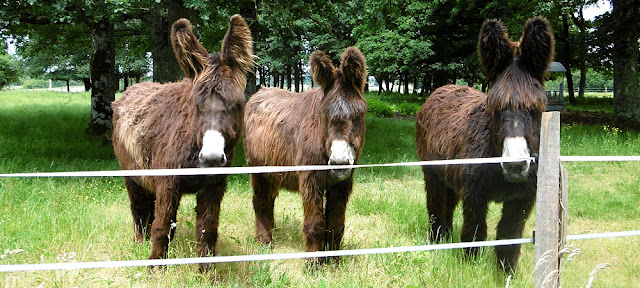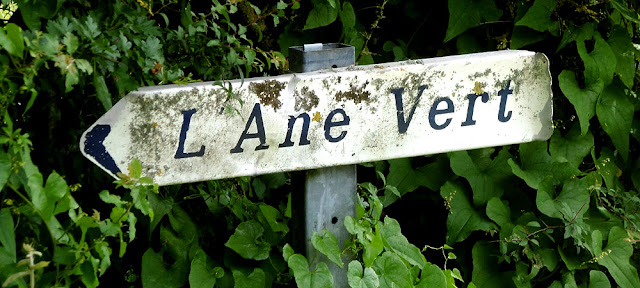On our recent foray to check out some local chateaux we came across a locality called L'Ane Vert ('the green donkey') -- and guess what! Right there in the field was a little troupe of three donkeys. They were dark bay, not green though -- the big hairy sort of the breed known as Poitou Ass or Baudet du Poitou.
Of course we enticed them over to us, but there was a ditch and an electric fence in the way, so we didn't get too up close and personal. They were gentle creatures, a bit prone to looking like pantomime horses. Their ears are like anti-static dusters, and very large -- a particular feature of the breed.
Left unclipped and ungroomed, as is traditional, the Poitou Ass develops dreadlocks which can hang to the ground. They are the largest breed of donkey, with legs and joints as large and sturdy as a carriage horse and were principally used to cross with Poitevin ('mule breeder') mares to get Poitevin Mules, a major source of labour and transport in the old days. The Poitevin Mule was considered the finest working animal in the world and every year about 30 000 were bred locally and sold globally. The specialist breeders were secretive and engaged in some very dubious practices which did not take into account the animals' welfare (pregnant mares were often starved in the belief that it would result in a more valuable mule colt foal, for example). With the increasing mechanisation of agriculture and transport of goods all three breeds started to die out after the Second World War. By the 1970s numbers had dwindled to around 40 purebred Poitou Asses and conservation efforts were required to save the breed.
Nowadays, after the French National Stud stepped in, there is a breed association dedicated to saving the breed and administering the pedigrees. Animals are chipped and DNA tested to ensure crossbred donkeys are not passed off as purebred, as the purebreds are worth so much more. Even so, there are still fewer than 500 purebred animals in the world. Most of the ones you see will be crossbreeds, retaining the shaggy look even if they only have a small percentage of Poitou Ass in their genes.
And no, we have no idea why the place was called 'the Green Donkey'.
************************************************
For details of our private guided tours of chateaux, gardens, wineries, markets and more please visit the Loire Valley Time Travel website. We would be delighted to design a tour for you.
We are also on Instagram, so check us out to see a regularly updated selection of our very best photos.
We are also on Instagram, so check us out to see a regularly updated selection of our very best photos.






10 comments:
Are this breed's big ears used as temperature regulators?
No idea to be honest.
Great article - very frustrated as unable to share to Facebook as apparently some users have reported your site - "Your message couldn't be sent because it includes content that other people on Facebook have reported as abusive."
You might want to contact Facebook to see why and get them to revoke the ban
best wishes
Simon
Green possibly due to their verdant and lush habitat? Or maybe the owner is thinking of Franz Marc's multicolored animals in Expressionist paintings from the Blaue Reiter perod?
So far FB appears to be uninterested in revoking the ban. They maintain that I am a spammer. I'm just ignoring it, can't be bothered to try to fight it.
I imagine this is a very old lieu-dit, nothing to do with the current residents. If it was England I would have assumed there was once a pub there called the Green Donkey. But it's in the middle of nowhere in France.
How odd :-(
How tedious social media...
They're adorable! Those ears are huge lol
They have a reputation for being very gentle and good natured.
Post a Comment